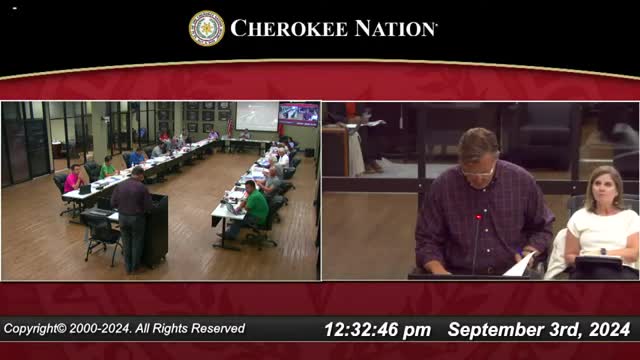Housing Assistance Program Aims to Support Cherokee Speakers
September 03, 2024 | Cherokee Nation, Oklahoma
This article was created by AI summarizing key points discussed. AI makes mistakes, so for full details and context, please refer to the video of the full meeting. Please report any errors so we can fix them. Report an error »

During a recent government meeting, discussions centered on budget allocations and funding sources for housing and community services, primarily focusing on the Department of Housing and Urban Development (HUD) and its impact on local projects.
Todd, a representative from the housing department, clarified that much of the funding discussed was sourced from HUD, with specific reference to the NC elderly speakers budget, which is part of the Indian Community Development Block Grant (ICDBG). He noted that as projects funded by this grant are completed, the associated budgets are decreasing, indicating a depletion of one-time funding.
The conversation also highlighted the importance of the Native American Housing Assistance and Self-Determination Act (NAHASDA) funding, which is crucial for housing rehabilitation projects. Todd explained that any project utilizing NAHASDA funding exceeding $2,000 requires adherence to Davis-Bacon wage standards, which ensures fair labor practices.
A significant increase in rental assistance funding by $2 million was announced, aimed at helping more individuals, particularly vulnerable populations such as the elderly and disabled. This increase is intended to reduce waitlists and provide timely support to families in need.
Howard Paden, representing the language department, addressed the ongoing challenges faced by Cherokee speakers, noting a concerning decline in their population. He reported that approximately $24 million has been invested in housing for speakers over the past few years, but the community continues to face significant housing needs. Paden emphasized the importance of ongoing assessments to better understand and address these needs.
The meeting concluded with positive feedback on recent housing initiatives, including the successful delivery of a trailer to a community member in need, underscoring the tangible impact of these programs on individuals and families. The discussions reflect a commitment to addressing housing challenges and improving living conditions for vulnerable populations within the community.
Todd, a representative from the housing department, clarified that much of the funding discussed was sourced from HUD, with specific reference to the NC elderly speakers budget, which is part of the Indian Community Development Block Grant (ICDBG). He noted that as projects funded by this grant are completed, the associated budgets are decreasing, indicating a depletion of one-time funding.
The conversation also highlighted the importance of the Native American Housing Assistance and Self-Determination Act (NAHASDA) funding, which is crucial for housing rehabilitation projects. Todd explained that any project utilizing NAHASDA funding exceeding $2,000 requires adherence to Davis-Bacon wage standards, which ensures fair labor practices.
A significant increase in rental assistance funding by $2 million was announced, aimed at helping more individuals, particularly vulnerable populations such as the elderly and disabled. This increase is intended to reduce waitlists and provide timely support to families in need.
Howard Paden, representing the language department, addressed the ongoing challenges faced by Cherokee speakers, noting a concerning decline in their population. He reported that approximately $24 million has been invested in housing for speakers over the past few years, but the community continues to face significant housing needs. Paden emphasized the importance of ongoing assessments to better understand and address these needs.
The meeting concluded with positive feedback on recent housing initiatives, including the successful delivery of a trailer to a community member in need, underscoring the tangible impact of these programs on individuals and families. The discussions reflect a commitment to addressing housing challenges and improving living conditions for vulnerable populations within the community.
View full meeting
This article is based on a recent meeting—watch the full video and explore the complete transcript for deeper insights into the discussion.
View full meeting
